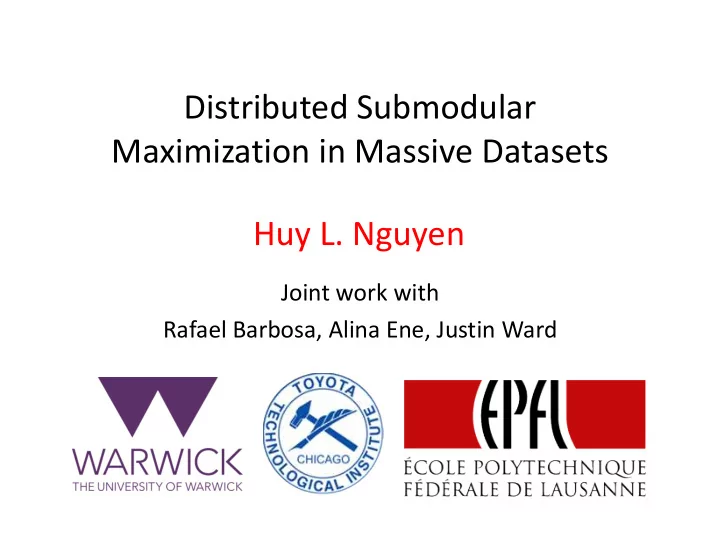

Distributed Submodular Maximization in Massive Datasets Huy L. Nguyen Joint work with Rafael Barbosa, Alina Ene, Justin Ward
Combinatorial Optimization • Given – A set of objects V – A function f on subsets of V – A collection of feasible subsets I • Find – A feasible subset of I that maximizes f • Goal – Abstract/general f and I – Capture many interesting problems – Allow for efficient algorithms
Submodularity We say that a function is submodular if: We say that is monotone if: Alternatively, f is submodular if: for all and Submodularity captures diminishing returns.
Submodularity Examples of submodular functions: – The number of elements covered by a collection of sets – Entropy of a set of random variables – The capacity of a cut in a directed or undirected graph – Rank of a set of columns of a matrix – Matroid rank functions – Log determinant of a submatrix of a psd matrix
Example: Multimode Sensor Coverage • We have distinct locations where we can place sensors • Each sensor can operate in different modes, each with a distinct coverage profile • Find sensor locations, each with a single mode to maximize coverage
Example: Identifying Representatives In Massive Data
Example: Identifying Representative Images • We are given a huge set X of images. • Each image is stored multidimensional vector. • We have a function d giving the difference between two images. • We want to pick a set S of at most k images to minimize the loss function: • Suppose we choose a distinguished vector e 0 (e.g. 0 vector), and set: • The function f is submodular. Our problem is then equivalent to maximizing f under a single cardinality constraint.
Need for Parallelization • Datasets grow very large – TinyImages has 80M images – Kosarak has 990K sets • Need multiple machines to fit the dataset • Use parallel frameworks such as MapReduce
Problem Definition • Given set V and submodular function f • Hereditary constraint I (cardinality at most k, matroid constraint of rank k, … ) • Find a subset that satisfies I and maximizes f • Parameters – n = |V| – k = max size of feasible solutions – m = number of machines
Greedy Algorithm Initialize S = {} While there is some element x that can be added to S: Add to S the element x that maximizes the marginal gain Return S
Greedy Algorithm • Approximation Guarantee • 1 - 1/e for a cardinality constraint • 1/2 for a matroid constraint • Inherently sequential • Not suitable for large datasets
Mirzasoleiman, Karbasi, Sarkar, Krause '13 Distributed Greedy
Performance of Distributed Greedy • Only requires 2 rounds of communication • Approximation ratio is: (where m is number of machines) • Can construct bad examples • Lower bounds for the distributed setting (Indyk et al. ’14)
Power of Randomness
Power of Randomness • Randomized distributed Greedy – Distribute the elements of V randomly in round 1 – Select the best solution found in rounds 1 & 2 • Theorem: If Greedy achieves a C approximation, randomized distributed Greedy achieves a C/2 approximation in expectation. • Related results: [Mirrokni, Zadimoghaddam ’15]
Intuition • If elements in OPT are selected in round 1 with high probability – Most of OPT is present in round 2 so solution in round 2 is good • If elements in OPT are selected in round 1 with low probability – OPT is not very different from typical solution so solution in round 1 is good
Power of Randomness • Randomized distributed Greedy – Distribute the elements of V randomly in round 1 – Select the best solution found in rounds 1 & 2 • Provable guarantees – Constant factor approx for several constraints • Generality – Same approach to parallelize a class of algorithms – Only need a natural consistency property – Extends to non-monotone functions
Optimal Algorithms? • Near-optimal algorithms? • Framework to parallelize algorithms with almost no loss? YES, using a few more rounds
Core Set
Core Set Send Core Set to every machine
Core Set
Core Set
Core Set Grow Core Set over 1/ rounds
Core Set Grow Core Set over 1/ rounds
Core Set Grow Core Set over 1/ rounds
Core Set Grow Core Set over 1/ rounds Leads to only an loss in the approximation Intuition Each round adds an fraction of OPT to the Core Set
Matroid Coverage Experiments Matroid Coverage (n=100, r=100) Matroid Coverage (n=900, r=5) It's better to distribute ellipses from each location across several machines!
Thank You! Questions?
Recommend
More recommend